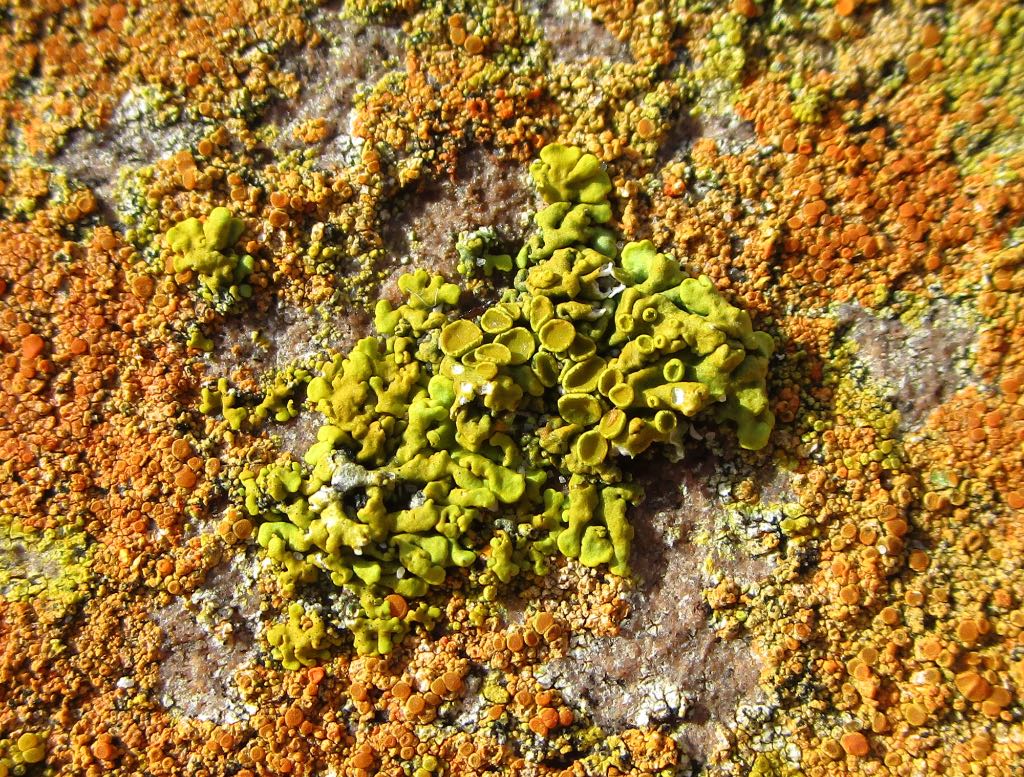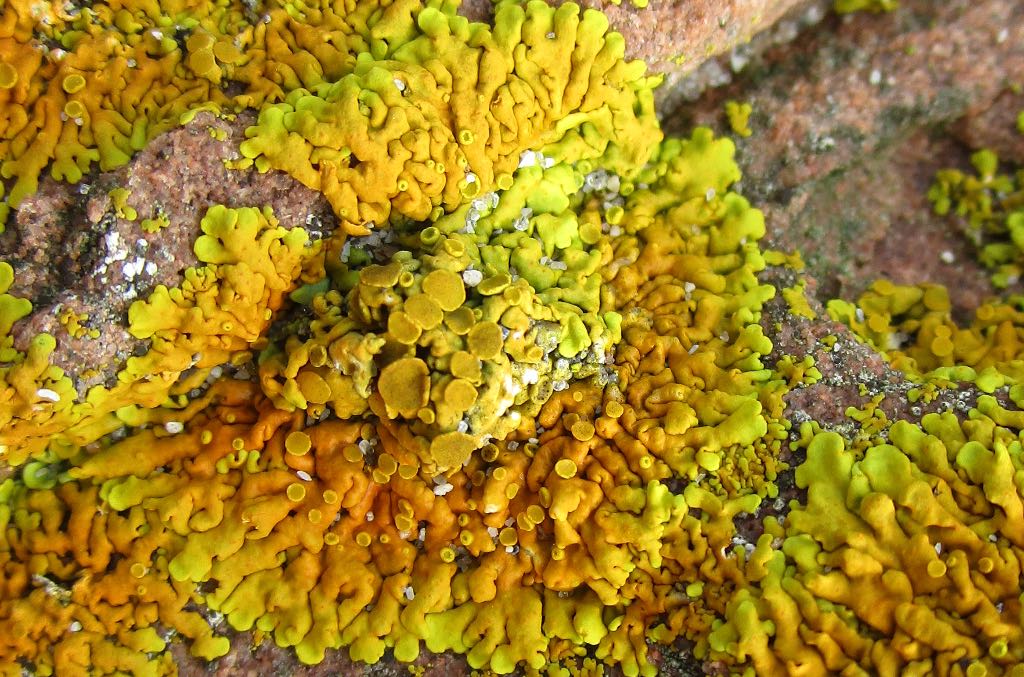
Photo Emu Bay, 2021/07/15, Canon Ixus 190
|
|
|
|
Emu BayEmu Bay is one of the more popular places for visitors to stay on Kangaroo Island. It has many choices in accommodation, good beaches and is fairly close to Kingscote, the biggest town and main shopping centre on KI.LichenOn this visit I was most taken with the lichen on the Emu Bay waterfront. |
|

|
Photo Emu Bay, 2021/07/15, Canon Ixus 190 |
|
This image shows better how the newer growth of the lichen is green while the older growth is orange. The depth of field is necessarily very shallow on a macrophotograph of high magnification.
|
The green and orange lichen is again present.
Photo 2021/07/15, iPhone 7
There is also a long sandy beach and a jetty.
Photo 2021/07/15, Canon Ixus 190
George's Castle
There doesn't seem to be a web site but there is a Facebook page.
Admission free! Please give a donation, I did.
Backstairs Passage
The photo was taken from the ferry that took us from Cape Jervis on the mainland to Penneshaw on KI, looking back toward the north-east.
Photo 2021/07/12, iPhone 7
Penneshaw
As in many places on KI, there were several excellent cafes in the town. Photo 2021/07/12, iPhone 7
Tammar wallabies, Penneshaw reserve
Note that the two on the right are sitting on their tails; this is common in tammars. Kangaroos don't do this, I don't know if some other wallabies do.
Photo 2021/07/17, Canon Ixus 190
Photo 2021/07/17, Canon Ixus 190
Cape Willoughby
Some other photos of Cape Willoughby are elsewhere on these pages.
Seal Bay
We have visited Seal Bay at least four times and have seen many sea lions each time (there are actual seals on other parts of KI). To go beyond the visitor's centre one must pay a fee and be accompanied by a guide. (There was a mother and pup sea lion sheltering against one of the walls of the visitor's centre.) The guide who came with us was very informative and friendly.
Photo 2021/07/13, Canon Ixus 190
Photo 2021/07/13, Canon Ixus 190
RegenerationRegeneration of the bush following the disastrous fires of late 2019 - early 2020The regeneration on KI seemed to be much quicker than that at Armagh following the fire of 2019/04/16.
The KI yakkas seem to typically larger than the same species on the Fleurieu Peninsula of South Australia and much bigger than the most common species Xanthorrhoea quadrangulata in Mid-North SA, where I live. The flower spike/seed head of the KI yakkas are particularly tall.
According to Wikipedia common names for Xanthorrhoea include grasstree, grass gum-tree (for its resin-yielding species), kangaroo tail and blackboy. In South Australia the most common name seems to be yakka (also spelled yacca and yakka).
Species present include Eucalypts, Xanthorrhoea and bracken fern.
The long trailing plant at the bottom could be Kennedia prostrata; common name running postman. The fern is commonly known as bracken fern, botanical name Pteridium esculentum. I have no idea what the very fine ground-covering plant is.
Flinders Chase |

|
|
A part of the view from Bunker Hill Lookout on the road to Cape Du Couedic, Admiral's Arch and Remarkable Rocks. As in so much of Kangaroo Island the bush in this area, mostly mallee, is recovering from the fires of late 2019 - early 2020.
The brown area on the left is probably a saline flat.
This area was also burned in December 2008; see a photo elsewhere on this site. |
I'm told that it is stimulated by fire and dies back after a few years.
Photo 2021/07/14, iPhone 7
Admiral's Arch, Flinders Chase
We didn't see seals in the Arch itself on the 2021 visit, but there were quite a few nearby.
Admiral's Arch is one of the very popular attractions of Kangaroo Island; there are many photos of it elsewhere on the Internet.
I don't recall ever seeing wood that has deteriorated to this state elsewhere and don't know anything about the cause. I can only assume that it is the sheltered highly saline environment.
Remarkable Rocks
I have unsuccessfully looked for a web site that gives a good explanation of the formation of Remarkable Rocks. (I'd be pleased if a reader could inform me of one, my email address is on the About Me page.)
My own understanding of the formation of the feature is that the magma that crystallised to form the granite of Remarkable Rocks invaded surrounding rocks at great depth many millions of years ago. As it was a huge mass of magma and at great depth it had time to form large crystals while is slowly solidified. Over many millions of years the land was very slowly raised, the covering rocks eroded away, until the granite intrusion itself was exposed to the weather.
Very very slowly wind, rain and salt-damp eroded the granite to form the present grotesque and fascinating shapes.
Surprisingly, considering the popularity of Remarkable Rocks and the number of tourists that we saw on KI, we had the place to ourselves for a short while.
The Cape Du Couedic lighthouse would be beyond the bay and just to the left of the edge of this image.
While the curved parts of the roof might appear to be convex, in fact they are actually concave.
The view is looking toward the north. A small section of the temporary path can be seen in the bottom right corner of the high definition image, and a little of the car park area is just visible in the distance on the extreme right.
|
|
|
IndexOn this page...
Admiral's Arch
Backstairs Passage Cape Willoughby Emu Bay Flinders Chase Admiral's Arch in Flinders Chase Remarkable Rocks in Flinders Chase George's Castle Lichen Penneshaw Tammar wallabies, Penneshaw reserve Regeneration Related pages Remarkable Rocks Seal Bay Tammar wallabies, Penneshaw reserve |